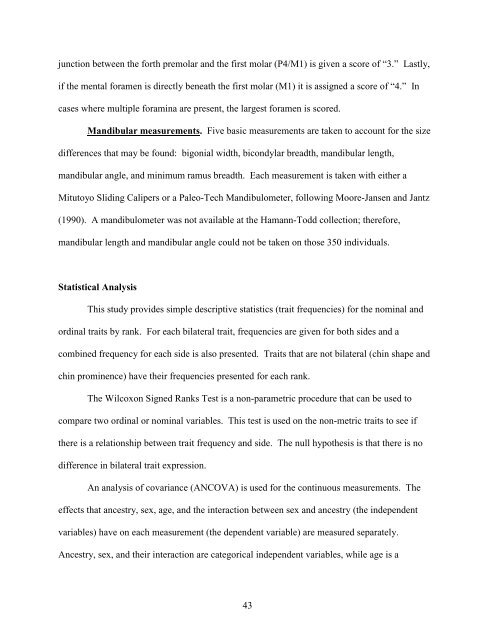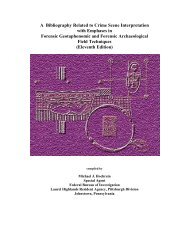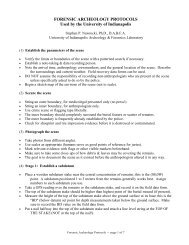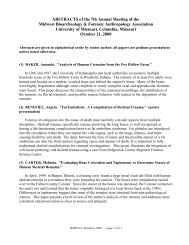Christopher W. Schmidt - University of Indianapolis Archeology ...
Christopher W. Schmidt - University of Indianapolis Archeology ...
Christopher W. Schmidt - University of Indianapolis Archeology ...
You also want an ePaper? Increase the reach of your titles
YUMPU automatically turns print PDFs into web optimized ePapers that Google loves.
junction between the forth premolar and the first molar (P4/M1) is given a score <strong>of</strong> “3.” Lastly,<br />
if the mental foramen is directly beneath the first molar (M1) it is assigned a score <strong>of</strong> “4.” In<br />
cases where multiple foramina are present, the largest foramen is scored.<br />
Mandibular measurements. Five basic measurements are taken to account for the size<br />
differences that may be found: bigonial width, bicondylar breadth, mandibular length,<br />
mandibular angle, and minimum ramus breadth. Each measurement is taken with either a<br />
Mitutoyo Sliding Calipers or a Paleo-Tech Mandibulometer, following Moore-Jansen and Jantz<br />
(1990). A mandibulometer was not available at the Hamann-Todd collection; therefore,<br />
mandibular length and mandibular angle could not be taken on those 350 individuals.<br />
Statistical Analysis<br />
This study provides simple descriptive statistics (trait frequencies) for the nominal and<br />
ordinal traits by rank. For each bilateral trait, frequencies are given for both sides and a<br />
combined frequency for each side is also presented. Traits that are not bilateral (chin shape and<br />
chin prominence) have their frequencies presented for each rank.<br />
The Wilcoxon Signed Ranks Test is a non-parametric procedure that can be used to<br />
compare two ordinal or nominal variables. This test is used on the non-metric traits to see if<br />
there is a relationship between trait frequency and side. The null hypothesis is that there is no<br />
difference in bilateral trait expression.<br />
An analysis <strong>of</strong> covariance (ANCOVA) is used for the continuous measurements. The<br />
effects that ancestry, sex, age, and the interaction between sex and ancestry (the independent<br />
variables) have on each measurement (the dependent variable) are measured separately.<br />
Ancestry, sex, and their interaction are categorical independent variables, while age is a<br />
43








